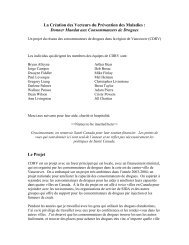The Injection Support Team - Vancouver Area Network of Drug Users
The Injection Support Team - Vancouver Area Network of Drug Users
The Injection Support Team - Vancouver Area Network of Drug Users
You also want an ePaper? Increase the reach of your titles
YUMPU automatically turns print PDFs into web optimized ePapers that Google loves.
498 W. SMALL ET AL.<br />
Subst Use Misuse Downloaded from informahealthcare.com by University <strong>of</strong> British Columbia on 03/28/12<br />
For personal use only.<br />
Importantly, the IST is also unique due to the fact that<br />
it operates to target unsafe and assisted injection by providing<br />
education and guidance, during the injection process,<br />
rather than providing safer injection education where<br />
injecting is not occurring. While the benefits <strong>of</strong> providing<br />
education and guidance during the injection process<br />
within SIFs have been documented (Fast, Small, Wood,<br />
& Kerr, 2008; Krüsi, Small, Wood, & Kerr, 2009; Wood<br />
et al., 2005), the IST delivers this type <strong>of</strong> education within<br />
the public drug scene, where it is much needed. <strong>The</strong> IST<br />
specifically targets consumption practices within public<br />
injection settings, and this focus on behavior within a drug<br />
consumption environment reflects the movement toward<br />
the development <strong>of</strong> safer injection environment interventions<br />
within the field <strong>of</strong> harm reduction (Kerr, Kimber, &<br />
Rhodes, 2007; Rhodes et al., 2006). By providing education,<br />
and an alternative to reliance upon assisted injection,<br />
the IST is addressing a key risk behavior as well as targeting<br />
high-risk drug consumption venue.<br />
Similar to other drug user organizations and druguser-led<br />
interventions (Friedman et al., 2007; Grund et<br />
al., 1992), the IST focuses upon an emerging health issue<br />
among PWID that is not adequately addressed by existing<br />
public health programs in the local setting. It also pushes<br />
the boundaries <strong>of</strong> conventional interventions and health<br />
services, which are <strong>of</strong>ten constrained by policies and<br />
regulations that impede the development <strong>of</strong> the most<br />
effective or accessible programs. In this regard, the IST<br />
represents a continuation <strong>of</strong> a tradition evident in harm<br />
reduction initiatives within the <strong>Vancouver</strong> setting and<br />
elsewhere, where drug-user-led efforts have preceded “<strong>of</strong>ficial”<br />
health programs employing similar interventional<br />
approaches. <strong>Vancouver</strong>’s needle exchange program was<br />
one <strong>of</strong> the first in North America, and a drug user founded<br />
this program during an era when needle exchange had not<br />
yet been incorporated into public health programming<br />
(Hankins, 1998). As described earlier, VANDU’s needle<br />
exchange program played a key role in precipitating<br />
developments that led to a city-wide syringe distribution<br />
policy for outlets and clinics operated by the local health<br />
authority (Kerr et al., 2006, 2010). Similarly, the unsanctioned<br />
SIF that VANDU operated prior to the opening<br />
<strong>of</strong> Insite represents another example <strong>of</strong> a drug-user-led<br />
program that was eventually incorporated into the <strong>of</strong>ficial<br />
public health response to drug-related harm in <strong>Vancouver</strong>.<br />
While the challenges faced by drug user groups and<br />
user-led projects have been thoroughly discussed (Friedman<br />
et al., 2007), it is important to note that some forces<br />
in the <strong>Vancouver</strong> context serve to facilitate the successful<br />
operation <strong>of</strong> user-led projects. <strong>The</strong> local health authority<br />
recognizes the value <strong>of</strong> drug-user-led initiatives and harm<br />
reduction efforts and provides some financial support to<br />
VANDU (Kerr et al., 2006), which has contributed to the<br />
longevity <strong>of</strong> the organization. An existing tradition <strong>of</strong> political<br />
activism in the DTES area and drug user mobilization<br />
in the local context represents a cultural factor that<br />
enhances the potential for successful drug user organizing<br />
in <strong>Vancouver</strong> (Osborn & Small, 2006). A health authority<br />
that supports drug user efforts to organize and previous<br />
activist experience on the part <strong>of</strong> drug users have<br />
previously been identified as conditions that may serve<br />
to promote formal drug user organizing, as an examination<br />
<strong>of</strong> user responses in Rotterdam demonstrates (Friedman<br />
et al., 2007). While the IST is composed <strong>of</strong> a highly<br />
motivated and committed group <strong>of</strong> individuals, the <strong>Team</strong><br />
also benefitted from the existing resources possessed by<br />
VANDU as the parent organization, which served to facilitate<br />
the successful operation <strong>of</strong> the program. VANDU<br />
provided crucial logistical and organizational support to<br />
the IST, assisting with practical aspects <strong>of</strong> the program by<br />
ordering and storing supplies, as well as providing a physical<br />
base for the operation <strong>of</strong> the program. It is also important<br />
to recognize that the IST emerged from VANDU<br />
and that all members had experience participating in userled<br />
programs and educational initiatives and were familiar<br />
with organizational processes including meeting<br />
procedures and group decision-making. It is clear that the<br />
ongoing operation <strong>of</strong> VANDU in the <strong>Vancouver</strong> context<br />
in many ways provided a platform for not only the development<br />
<strong>of</strong> the IST but also the successful operation <strong>of</strong><br />
the program. It is recommended that efforts to implement<br />
similar programs in other settings should build on the existing<br />
resources and capacity <strong>of</strong> local drug user organizations<br />
when launching new initiatives.<br />
<strong>The</strong>re are some important limitations <strong>of</strong> the IST program<br />
that should be noted, and these issues represent<br />
directions for future action. While the IST reduces reliance<br />
upon assisted injecting and fosters safer injecting in<br />
public injection settings, the outreach program is unable<br />
to address some important contextual forces which drive<br />
injection-related risk in these venues (Dovey, Fitzgerald,<br />
& Choi, 2001; Small et al., 2007). Although the IST<br />
fosters safer assisted injection, the impact <strong>of</strong> these efforts<br />
would be maximized if assisted injections could be<br />
relocated to an <strong>of</strong>f-street location. Notably, the unsanctioned<br />
SIF that operated prior to Insite did permit assisted<br />
injections. <strong>The</strong> operation <strong>of</strong> the unsanctioned facility<br />
demonstrated that when assisted injections occur within a<br />
supervised setting, this provides enhanced opportunities<br />
to mediate the risks associated with this practice<br />
(Kerr et al., 2005a). Furthermore, some drug consumption<br />
rooms in Europe are able to successfully accommodate<br />
assisted injections on-site, as these state-run facilities<br />
permit assisted injections delivered by other clients<br />
(Kimber, Dolan, & Wodak, 2005). <strong>The</strong>refore, modifications<br />
to the current operating policies and regulations<br />
<strong>of</strong> Insite should be pursued, although permitting<br />
nurse-assisted or peer-assisted injection would require<br />
amendments to the current regulatory framework governing<br />
SIFs in Canada, as well as measures to address<br />
civil and criminal liability related to assisted injection<br />
(Pearshouse & Elliott, 2007). Finally, due to the important<br />
role that “hit doctors” play in shaping injection safety, in<br />
settings where SIFs are not feasible, social network<br />
interventions targeting individuals who regularly provide<br />
assistance with injection should be pursued in order to<br />
enhance injection safety and foster capacity for selfinjection.





